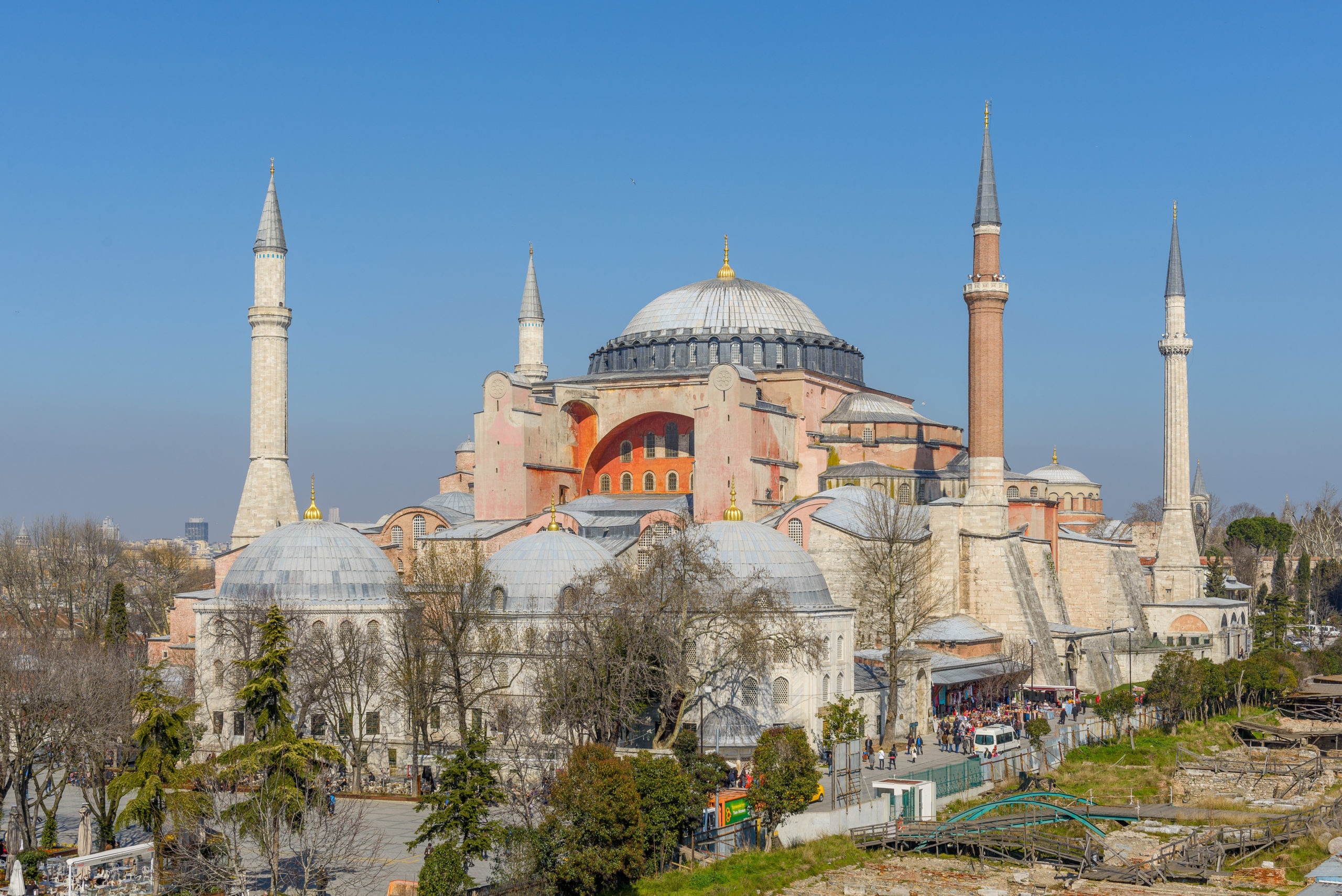
Istanbul links Asia with Europe. The city is situated on both sides of the Bosphorus, the narrow waterway that separates the two continents. It is roughly 31 kilometers/19.3 miles in length and less than 1 kilometer/ 0.6 miles wide. For millennia, boats have routinely ferried wayfarers across the divide, as they still do today. In the late twentieth century, the city bridged this intercontinental divide. The Bosphorus Bridge opened in 1973, followed by the Conqueror’s Bridge in 1988, named after Sultan Mehmed II, who transformed the city into the imperial capital of the Ottoman Empire in 1453. A third bridge opened in 2016, named after Mehmed II’s grandson, Sultan Selim I (r. 1512–1520), who asserted Ottoman control over Arab lands from Syria to Egypt, became protector of Mecca, and defeated the Shi’ite Persians in the east. Still further increasing the connection, a tunnel underneath the Sea of Marmara, completed in 2013, allows for rapid transit between Asia and Europe via the city’s metro system.
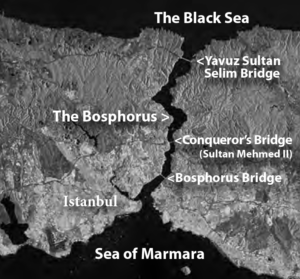
Istanbul also links north and south. Ships move from the Black Sea through the Bosphorus, into the Sea of Marmara, past the narrow straits of the Dardanelles, and then on to the Aegean, Mediterranean, and beyond, heading west to the Atlantic or south through the Suez Canal to the Indian Ocean. Approximately 40,000 to 50,000 vessels move through the Bosporus each year, testifying to the city’s centrality in regional and global trade. Such is the volume that Turkish authorities have proposed carving a parallel canal, serving as a second Bosphorus, to facilitate the traffic. Not surprisingly, then, Istanbul is Europe’s largest metropolis, as well as the economic and cultural capital of Turkey, which is predominately an Asian country, with less than 5 percent of its territory and 10 percent of its population in Europe. Yet Turkey is a long-established member of the North Atlantic Treaty Organization, which also exercises an influential role in the Middle East and broader Muslim world. Istanbul is truly at the crossroads of the world.

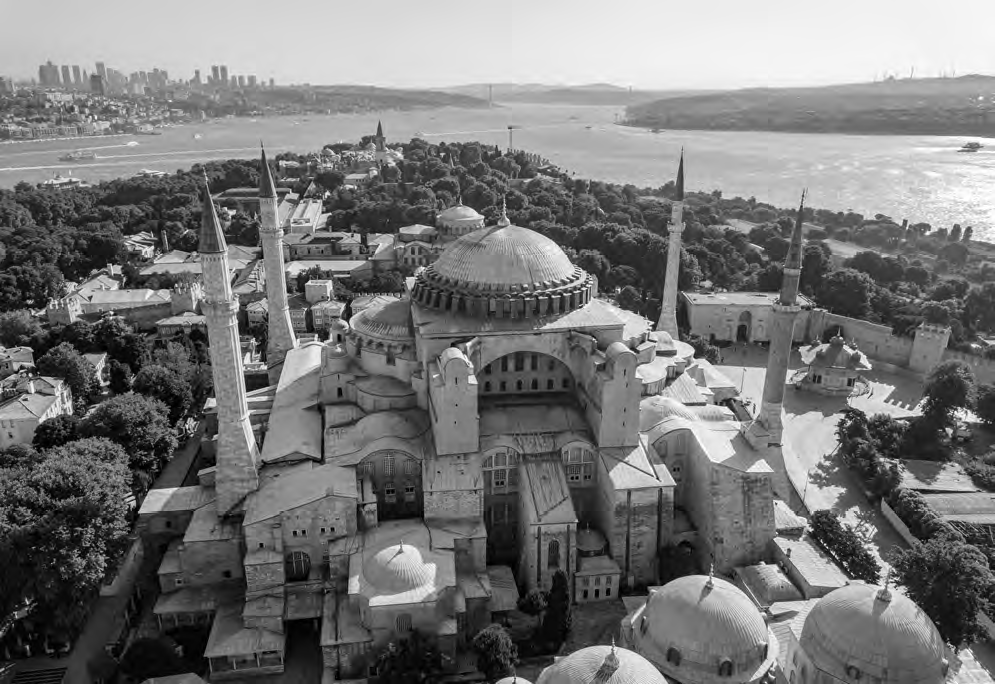
Istanbul’s history stretches back three millennia from its foundation in the seventh century BCE as the Greek colony of Byzantion (Byzantium in Latin) to its transformation in the fourth century CE into Constantinople, the Christian “New Rome,” capital of the Roman Empire in the eastern Mediterranean. Its next phase as a Muslim imperial capital began in the fifteenth century, and then in the twentieth century it transformed to its current status, not as an imperial or national capital, but as Turkey’s largest city and cultural center (the capital is Ankara, a less heralded site, though more centrally located in its Asian territory).
Istanbul is replete with monuments of historical grandeur, including Ottoman palaces, imposing mosques, sprawling marketplaces, majestic churches, ancient aqueducts, monumental walls, and a Roman hippodrome, but the greatest of these is Hagia Sophia (meaning “Holy Wisdom” in Greek), or Ayasofya as it is known today.1 This massive structure was a manifestation of Roman (or Byzantine) wealth and technological advancement.2 The building towers over the heart of “downtown” Constantinople like a sacred mountain overlooking the surrounding city and adjacent sea. Located nearby are the imperial palace, administrative buildings, the Senate house, imperial monuments, other churches, a large public square, and the monumental hippodrome. The location was the terminus of an urban thoroughfare guiding movement from the city walls to the downtown urban center adjacent to the waterfront at the confluence of the Sea of Marmara, Bosphorus, and a narrow inlet known as the Golden Horn. Under the Ottomans, this centrality continued, replacing Byzantine structures with Ottoman ones, and converting the church into the city’s most important mosque. When the Republic of Turkey was born after World War I, Hagia Sophia morphed into a new form, not as a Christian or Muslim sanctuary, but as a secular sanctuary of knowledge—a museum. It became the most visited historic site in Turkey, with millions paying the entry fee for a visit. The twenty-first century has witnessed another historical turning point, when, in summer 2020, Muslim prayers again echoed through the building’s interior as the museum was metamorphosed back into a mosque.
This alteration was expected because Hagia Sophia has always served as a primary marker of the region’s dominant belief system. It broadcast the supremacy of Christianity for a millennium, then Islam for five centuries, then secularism in the twentieth century, until its current phase in the twenty-first century. Hagia Sophia’s current status as a mosque reflects the political and religious outlook of Turkey’s dominant political authority, the Justice and Development Party (Adalet ve Kalkınma Partisi, or AKP), which has controlled the nation during the century’s opening decades. These changes reveal the centrality of the building in a city that is itself central to national, regional, and even global history.
Hagia Sophia was built in the fourth century, a few decades after Emperor Constantine founded the city on May 11, 330, absorbing the existing, smaller settlement of Byzantium. This first Hagia Sophia burned down during riots that engulfed the capital in the early fifth century, stemming from tensions between imperial and ecclesiastical authorities. This second church was destroyed in the most notorious urban tumult in the city’s history, the Nika Riot.
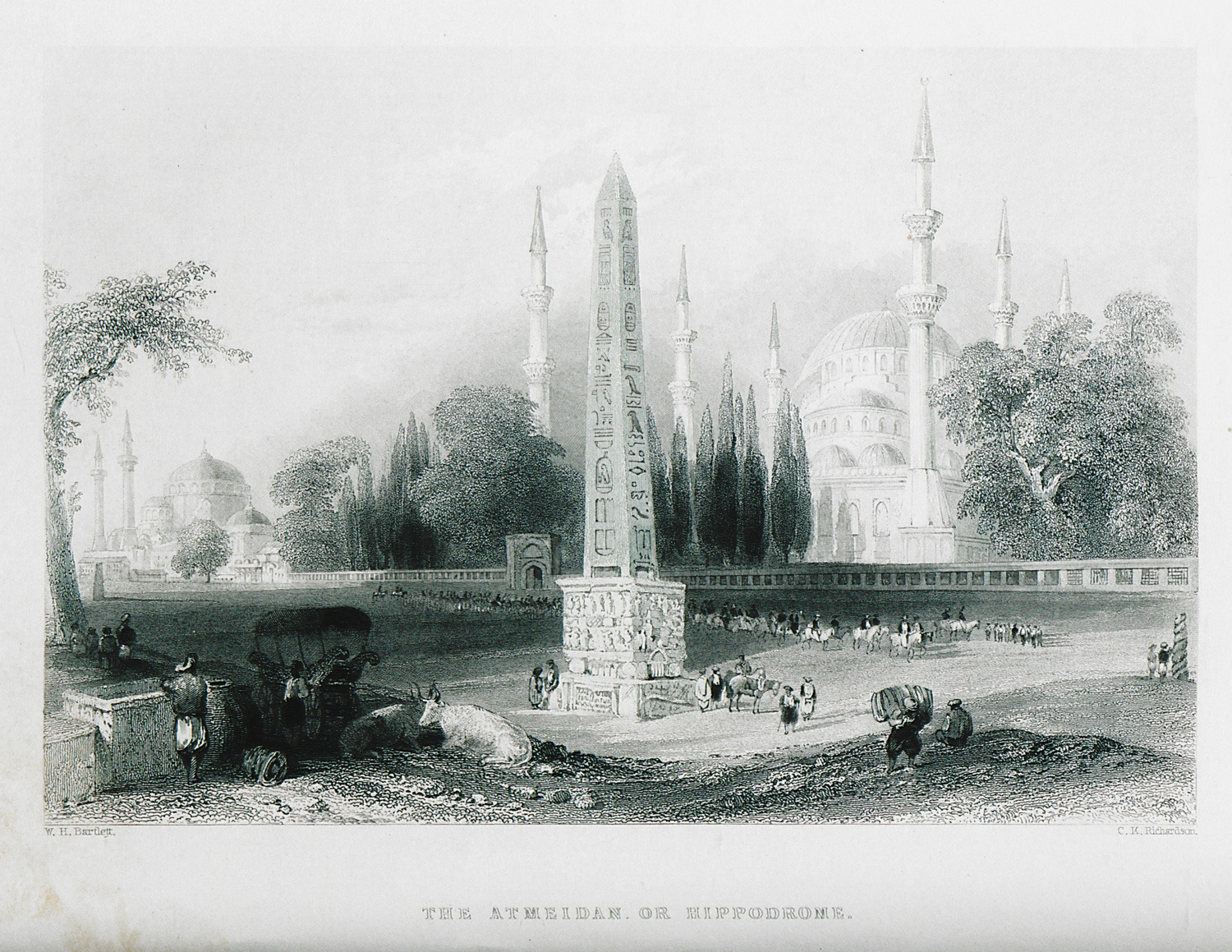
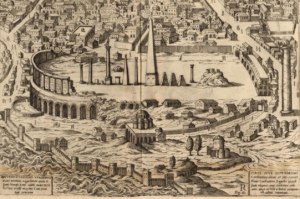
This insurrection was a response to reforms of Emperor Justinian (r. 527–565).3 The emperor’s administrative changes aimed to improve tax collection and bureaucratic efficiency, strengthen imperial control, and reduce corruption. These reforms were accompanied by a review and reorganization of Roman law that produced the Corpus Juris Civilis, an achievement as important as its parallel in stone, Hagia Sophia. This program conveyed an ideological message that Justinian, guided by divine favor, was restoring the state to its past grandeur
The spark that launched the riot was ignited in the public games, the chariot races in the hippodrome, where 80,000 people congregated. The rioters ran amok and razed much of downtown Constantinople, shouting “nika” (“conquer”) as they rampaged. As the city burned, the crowd demanded the deposition of high-ranking officials associated with the reforms and even began calling for a new emperor, looking to a member of the imperial family that had preceded Justinian’s. Anticipating the end of the emperor’s reign, many elites rallied to the rival claimant. Yet, emboldened by the steadfastness of Empress Theodora, Justinian held firm and loyal commanders mounted a brutal suppression of the uprising. The death toll was said to reach 30,000.

Justinian punished the disloyal elites, executed the imperial claimants, and immediately began building, broadcasting his message of imperial power and renewal. On the rubble of the former church emerged a vastly more monumental Hagia Sophia. The emperor entrusted the project to two scientists and mathematicians, Athemius of Tralles and Isidore of Miletos, whose architectural model was innovative in design and scale: a structure measuring 70 by 75 meters (230 by 246 feet), topped by an enormous dome spanning more than 31 meters (100 feet) across, resting 33 meters (180 feet) above the ground, and supported by surrounding halfdomes. Completed on December 27, 537, Hagia Sophia was then the Christian world’s largest church, and the emperor boasted that he had surpassed King Solomon’s (no longer extant) temple in Jerusalem. The monument served as an expression of imperial supremacy over all others, both past and present. Hagia Sophia expressed in stone the majesty of Justinian and his partner, Theodora, whose monograms are inscribed into the capitals of the interior columns, like signatures across the centuries.
Hagia Sophia was also a statement of the supremacy of Christianity and the empire’s technological and economic preeminence over rivals both East and West, against whom the empire was at war. The scale of this architectural accomplishment was so profound that it had no significant imitation in the Christian world for a millennium. One contemporary observer, the historian Prokopios, suggested that if anyone could have known that the building would be so splendid, they would have called for the destruction of its predecessor. Experiencing it was overwhelming, “for each detail attracts the eye and draws it on irresistibly to itself. So the vision constantly shifts suddenly, for the beholder is utterly unable to select which particular detail he should admire more than all the others.” Particularly mesmerizing is the effect of light in the interior because “[t]he whole ceiling is overlaid with pure gold, which adds glory to the beauty, yet the light reflected from the stones prevails, shining out in rivalry with the gold.” The monument seems to reflect the presence of the divine hand: “And whenever anyone enters this church to pray, he understands at once that it is not by any human power or skill, but by the influence of God, that this work has been so finely tuned. And so his mind is lifted up toward God and exalted, feeling that he cannot be far away, but must especially love to dwell in this place which he has chosen …. of this spectacle no one has ever had a surfeit.”4
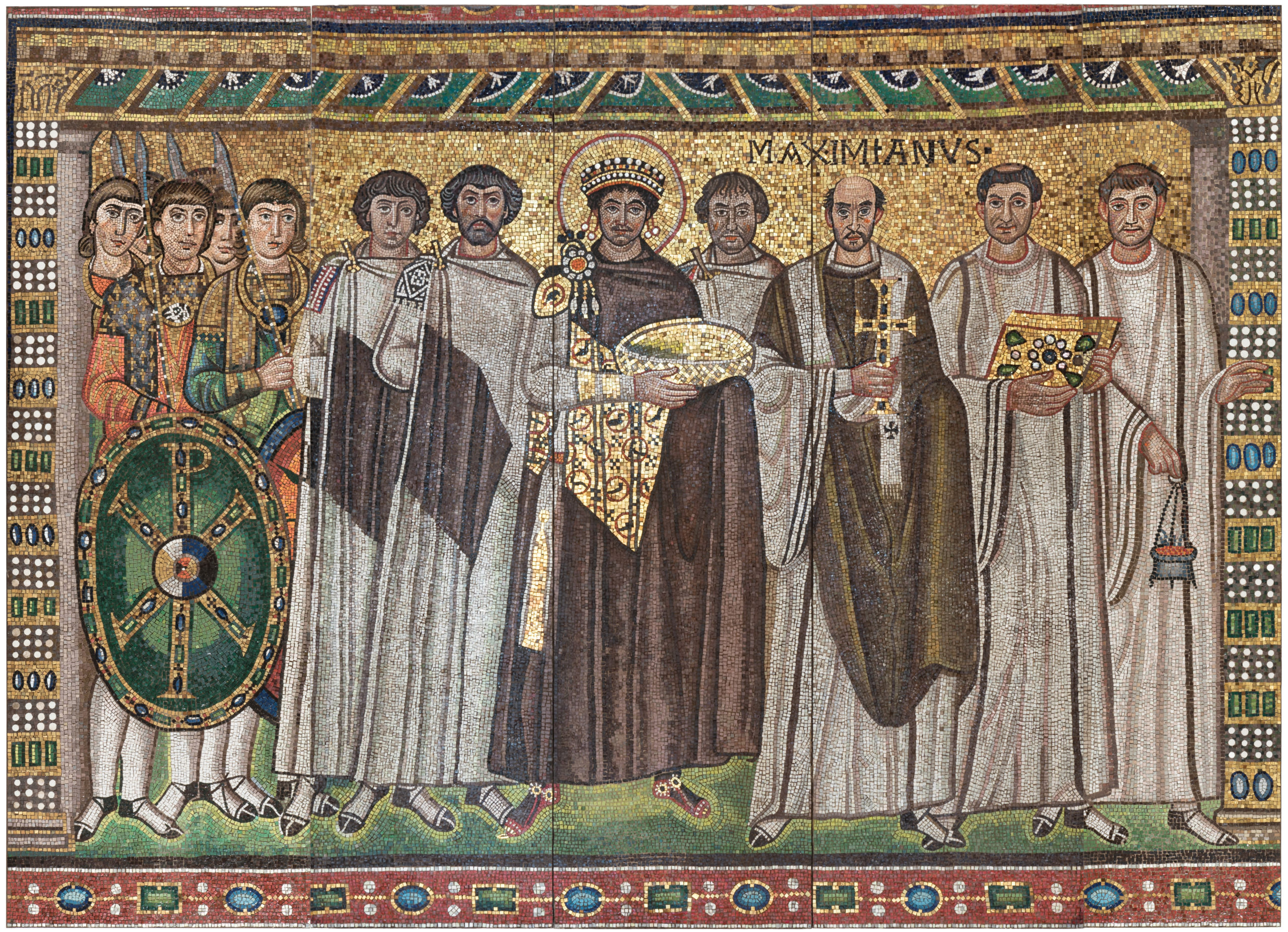
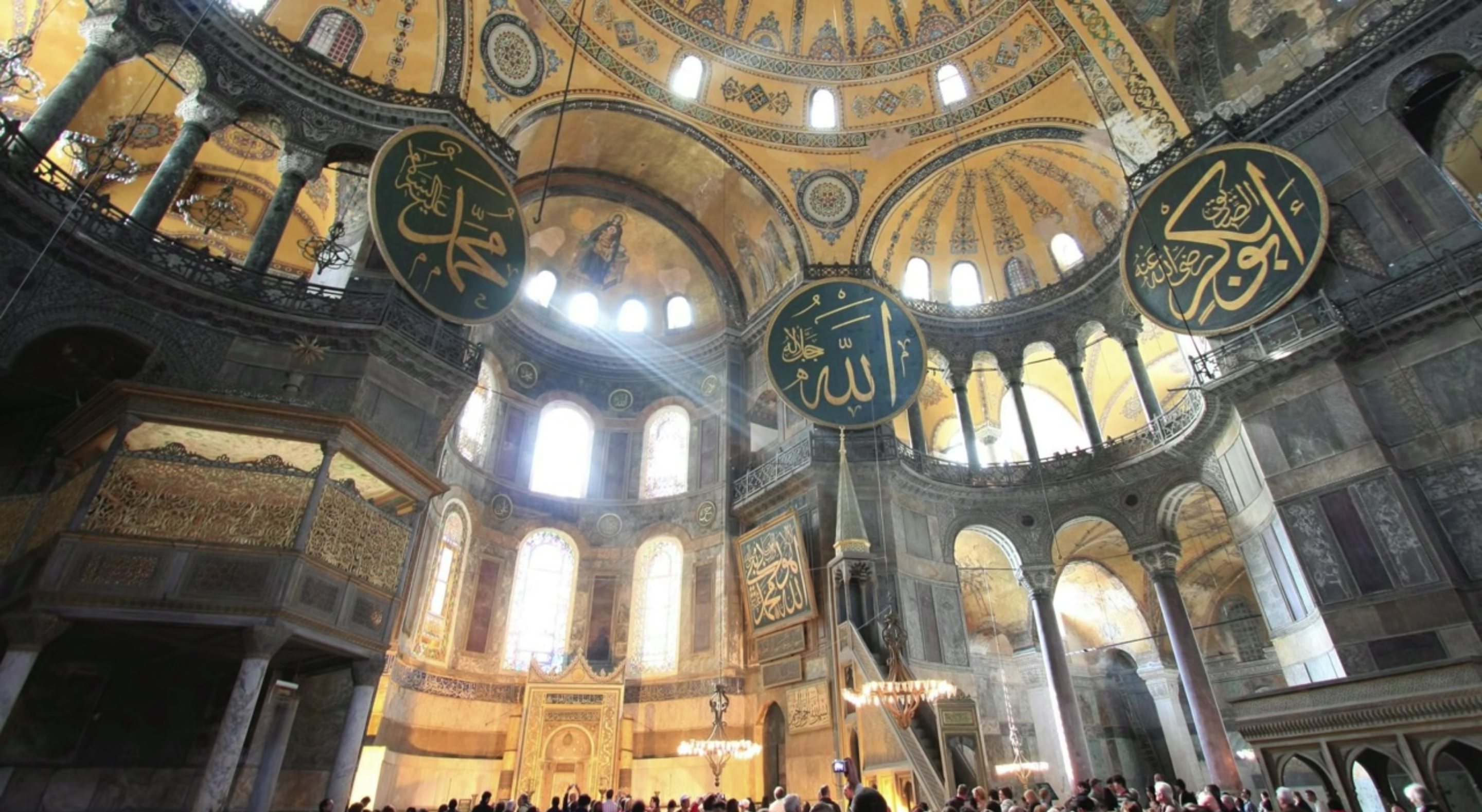
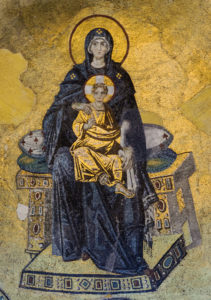
Enhancing the sensory experience is the marble floor itself. Its blocks were carved from the nearby island of Prokonnesos in the Sea of Marmara. There is a profound connection between the building, the stone, and the sea, so much so that the Greek term for marble, marmara, became the name for that island and then for the surrounding sea. The floor of the building offers the illusion of waves on the sea. This effect is created by choosing marble with particular seams, then slicing the slabs and setting them so as to make series of continuous veins across the floor, resembling waves. There are theological implications here, linking these waters in stone with the biblical creation account in Genesis and with the waters flowing from the throne of God as described in Revelation. The building’s structure offers a theological and even mystical encounter. Yet, if one were unaware of such connections, there is still the visceral experience, as one sixth-century poet expressed:
Through the spaces of the great church come rays of light, expelling clouds of care, and filling the mind with joy. The sacred light cheers all: even the sailor guiding his bark on the waves . . . and winding a sinuous course amidst creeks and rocks, with heart fearful at the dangers of his nightly wanderings—perchance he has left the Aegean and guides his ship against adverse currents in the Hellespont [the Dardanelles, heading toward Constantinople], awaiting with taut forestay the onslaught of a storm . . . [guided] by the divine light of the church itself. Yet not only does it guide the merchant at night . . . but it also shows the way to the living God.5
Envoys sent by Prince Vladimir of Kiev had a similarly magnetic experience when they visited the building in the tenth century, leaving them awestruck. They confessed, “We knew not whether we were in heaven or on earth. For on earth there is no such splendor or such beauty and we are at a loss how to describe it. We only know that God dwells there among men.”6 Kiev and Russia converted to Orthodox Christianity and became culturally linked to Constantinople, its church, and its empire.
Because of the building’s primacy as a monument of imperial influence, later emperors sought to forge connections through renovation and addition. One means for an addition was through decorative art, evident in the church’s many mosaics. The earliest is the mosaic of the Virgin Mary with infant Jesus, which draws the viewer’s eyes upward to the apse. This mosaic was completed after a long theological struggle over the orthodoxy of images in the eighth and ninth centuries. This church—and city—played a leading role in the debate, as it did for the development of what has become fundamental Christian theology for Orthodox, Catholic, and most Protestant Christians today, from the Christian understanding of the Trinity and Christology (i.e., the relationship between Jesus’s human and divine natures) to the creeds professed in worship. These theological principles were carefully worked out through seven Ecumenical (meaning “universal”) Councils, all of which took place in or near Constantinople: the First in 325 at Nicaea (before Constantinople was founded in 330, but close by), the Second in Constantinople in 381, the Third in 431 in Ephesus on the Aegean coast of Turkey, the Fourth in Chalcedon (across from the city, on the Asian side of the Bosphorus) in 451, the Fifth and Sixth in Constantinople in 553 and 680, and the Seventh at Nicaea in 787 (this was planned for Constantinople but moved due to political circumstances at the time). Thus, Hagia Sophia was at the heart of much Christian theological development, a fact that escapes most contemporary Christians.
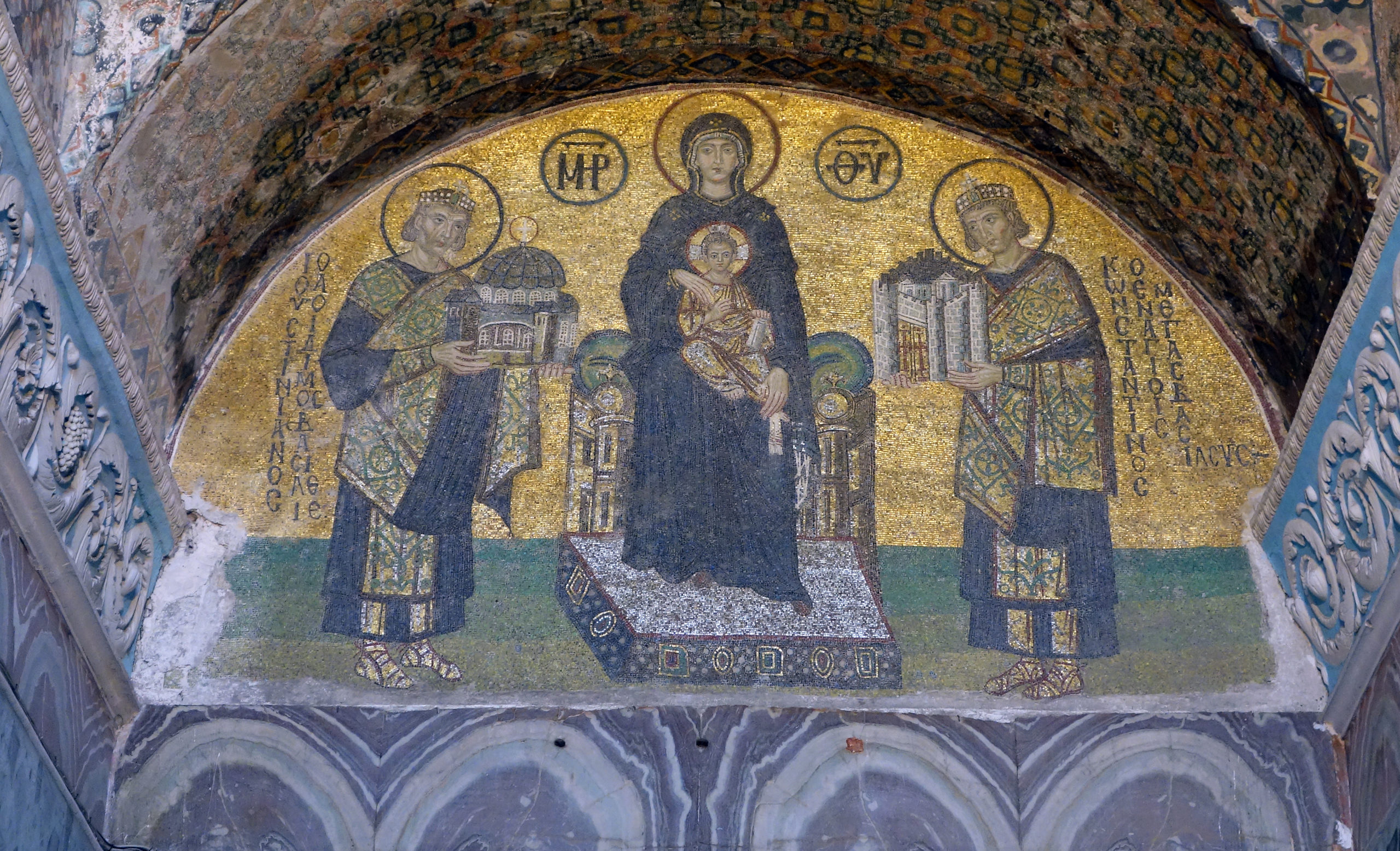
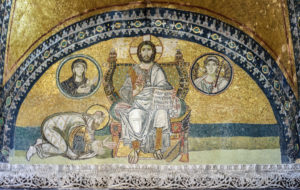
Returning to the image of the Virgin in the apse, this mosaic represents the triumph of Orthodoxy over the heresy of Iconoclasm, the anti-image theological position that was defeated at the Seventh Ecumenical Council. Centuries later, this same image was plastered over during the Ottoman Era in accordance with Islam’s iconoclast orthodoxy, then uncovered when the building became a museum, and today is covered by curtains during prayers.
The building’s mosaics promote the sanctity of the capital by showcasing saints with Constantinopolitan connections, such as Patriarch John Chrysostom (d. 407), one of Christianity’s greatest preachers and advocates for the poor. These accentuated the holiness of the patriarchal church and of those entrusted to oversee the empire’s ecclesiastical administration. Moreover, the church also has a vast storehouse of Christian relics, from the apostolic era to its present, which enhance this as a sacred site.
The imperial presence is also represented in mosaic form. One very large image portrays emperors Constantine and Justinian, the two figures who shaped the Byzantine worldview: Constantine founded the city in the fourth century, and Justinian was responsible for the very monument in which the viewer was standing. Above the massive imperial doorway separating the narthex and the sanctuary, a mosaic displays the piety of an emperor, shown kneeling before the enthroned Jesus. Other extant portraits include Emperor Alexander (r. 912–913); Empress Zoe (r. 1028–1050) and her husband, Constantine IX Monomachos (r. 1042–1055); and John II Komnenos (r. 1118–1141) and his Hungarian wife, Irene (d. 1134), with their son, Alexios (d. 1142).
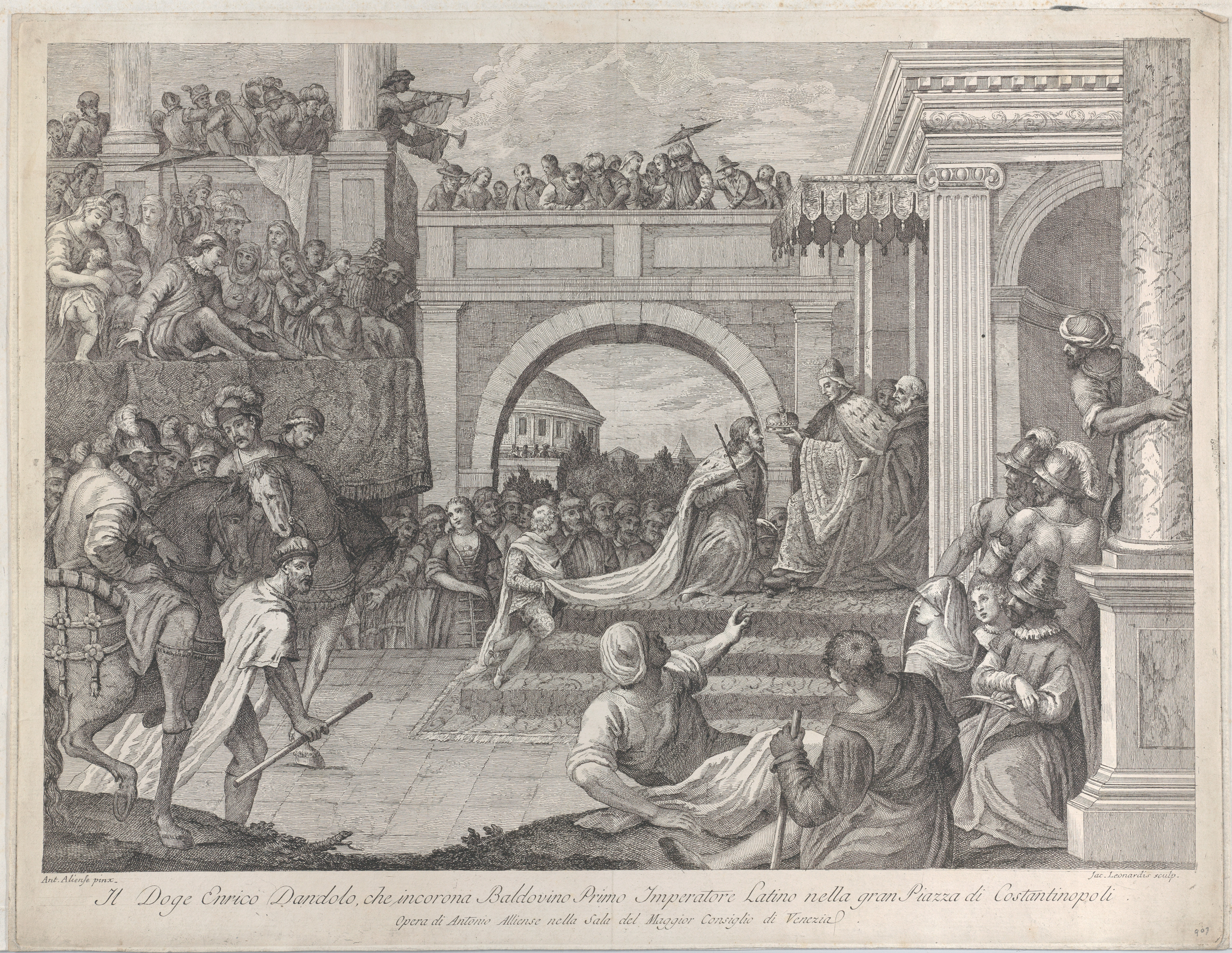
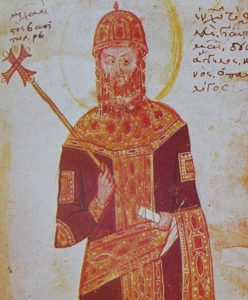
Only decades after the latter mosaic was completed, Catholic Crusaders of the Fourth Crusade sacked Constantinople in 1204.7 During the preceding century, three Crusades (1096–1192) had increased tensions between Constantinople and Western armies, which passed through en route to the Holy Land. This tension culminated in this Western assault against the Orthodox empire, resulting in Catholic supremacy in Constantinople. Discord between these two branches of Christianity was centuries old, but they only officially separated in 1054 through mutual condemnations between the bishop of Rome (the pope) and patriarch of Constantinople. The Crusades widened this ecclesiastical rift into a permanent cultural and religious divide between Catholic and Orthodox Christianity. The conquerors imposed a Catholic emperor and Catholic bishop, and appropriated Hagia Sophia for the Catholic liturgy. The city and building suffered during the assault, and their upkeep was neglected for decades. The Crusaders plundered the Christian relics and precious objects, including the Crown of Thorns, which passed to King Louis IX, inspiring his construction of St. Chapelle in Paris. One vestige of this Catholic occupation is the tombstone of Enrico Dandolo (d. 1205), the Venetian leader who led the assault against the city. The marker does not, however, date from the medieval period. The doge’s body was unceremoniously discarded by the Ottomans after their conquest, leaving the tomb’s original location unknown. The present marker was set by the Fossati brothers, the Italian-Swiss architects hired by Sultan Abdülmecid to restore Hagia Sophia in 1847–1849 (discussed below).
Hagia Sophia was restored to Orthodox Christianity by Emperor Michael VIII Palaiologos (r. 1259–1282), founder of the Palaiologan Dynasty, the empire’s last. Michael recaptured Constantinople in 1261 and spent the following decades holding off the imminent threat of a second Western conquest, while attempting to restore the city after much neglect. He presented himself as a new Constantine, a new founder of the city. Hagia Sophia was rededicated as an Orthodox church, and Michael was crowned emperor there, site of the traditional imperial coronation ceremony. Michael may have commissioned a large mosaic of the deësis (“supplication”) in the second-floor gallery to entwine himself with the building’s history. The mosaic presents Christ between the Virgin and John the Baptist, who intercede on the world’s behalf.
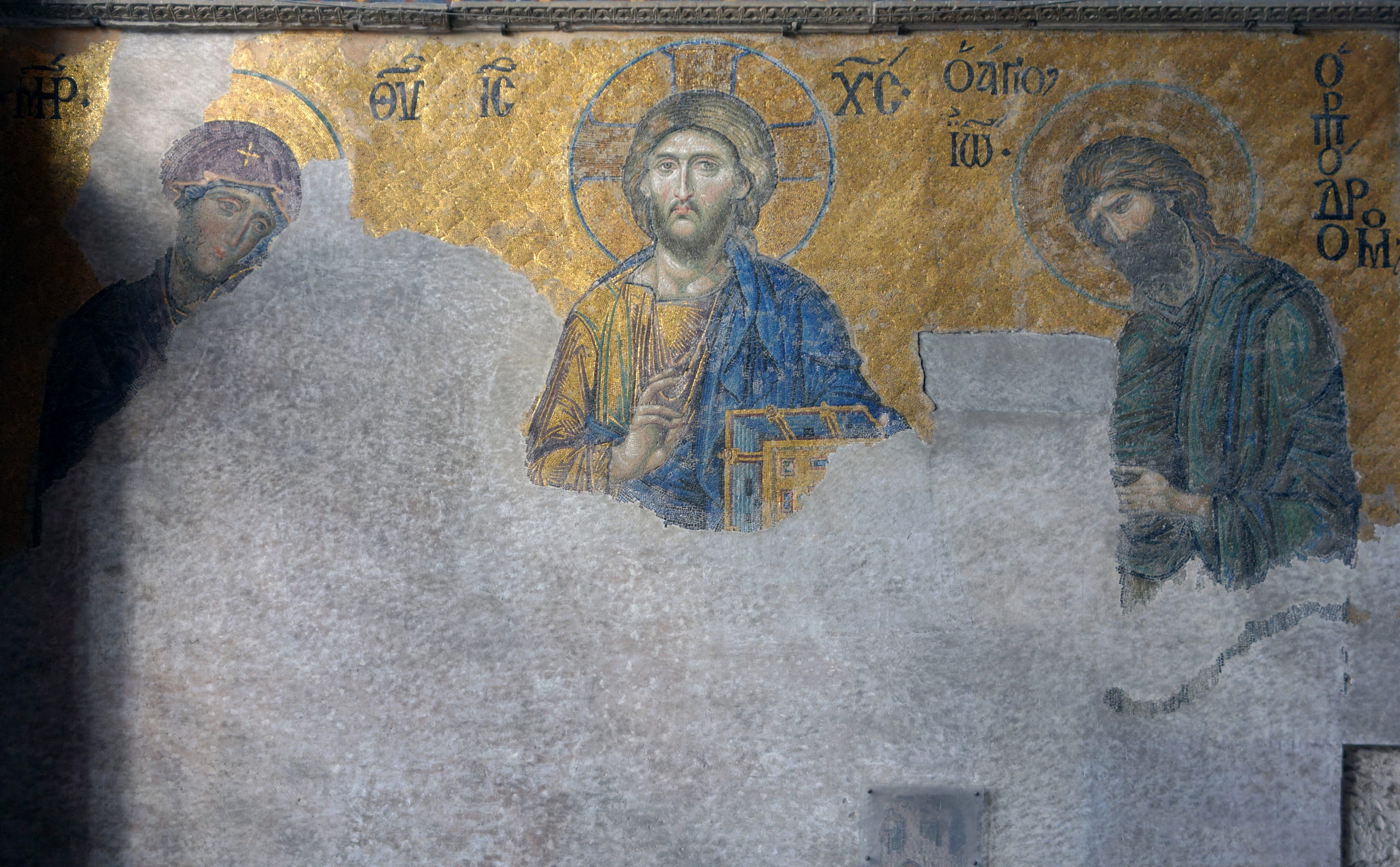
After Michael’s death, the empire struggled financially and politically against increasingly powerful antagonists. Yet it did muster resources (including donations from Russia) to protect Hagia Sophia against the ravages of earthquake. Michael’s son, Emperor Andronikos II Palaiologos (r. 1282–1328), added buttresses on the north and south sides, which strengthened the building before the next tremor in the 1340s, which damaged the eastern arch, bringing down one-third of the dome in 1346. Given the financial straits of the late empire, it took another decade to repair.
Earthquakes have always been a reality in the long history of Istanbul, which rests on the 1,200-kilometer (560-mile) North Anatolian Fault. Not long after Hagia Sophia was completed, an earthquake caused the eastern portion of the original dome and its supporting structure to give way in 558. Justinian had the dome fortified by raising it several meters and adding the first buttresses to the exterior of the building, the first modifications to the building’s appearance, celebrating a rededication in 563. Hagia Sophia withstood earthquakes in following centuries, and more buttresses were added. In 989, an earthquake caused the dome to partially collapse, and Emperor Basil II (r. 976–1025) hired Trdat, an Armenian architect and designer of the cathedral at Ani, who successfully restored the dome, celebrating its rededication in 996. By the fourteenth and fifteenth centuries, emperors lacked the wealth of their imperial predecessors and struggled to maintain the building, just as they struggled to protect the empire against emerging threats. Leading among these were the Ottoman Turks, who seized former imperial territories in Anatolia and the Balkans until there was little left but Constantinople.
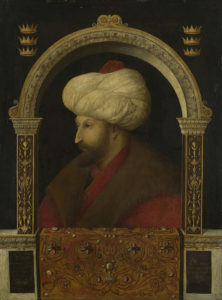
The Ottoman siege began in April 1453. On Tuesday, May 29, Sultan Mehmed II (r. 1451–1481) rode into the city through its battered walls, making his way directly to Hagia Sophia. He had just become Fatih (“the Conqueror”). The sultan entered the sacred site, sprinkling dust upon his turban beforehand out of humility and reverence. In Hagia Sophia, Mehmed saw the inheritance of imperial power, a monument to co-opt, leaving even its name intact. Constantinople became the new Ottoman capital and Hagia Sophia its most important mosque.8 Purged of (some) Christian symbols, the building now signified the region’s new dominant religion, with the sound of church bells in the city replaced by the muezzin’s call to prayer. The Christian patriarch, the empire’s highest ecclesiastical authority, was evicted from his residence in Hagia Sophia and forced to relocate elsewhere in the city, eventually settling at the patriarchate’s present location at the Church of St. George in Istanbul’s Fener neighborhood on the Golden Horn.
Mehmed invested in the restoration of Ayasofya, as it became known, which had suffered from deferred maintenance. The sultan had to retrofit the sanctuary for Muslim worship, adding the mihrab (prayer niche), which denotes the direction of Mecca toward which worshipers pray. The niche, however, is off center, since the sultan was unable to turn the entire building to align it with the architectural protocol. The sultan added a minbar (pulpit, though the present one dates from the seventeenth century), the building’s first minaret, and more buttresses. After his reign, additional buttresses and minarets were added in the sixteenth century by Mimar Sinan, the most famous Ottoman architect. Thus, the building as we see it today, with its four minarets, many buttresses, and still other additions, reflects a long process of development that has altered its appearance from the building that Justinian commissioned.
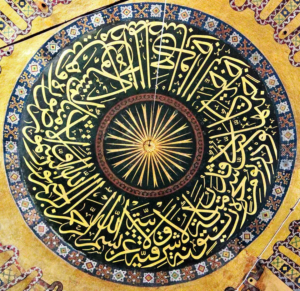
Source: Hagia Sophia website at https://tinyurl.com/448r9jhr.
The calligraphy in the main dome of Hagia Sophia is The Verse of Light—the 35th verse of the 24th surah of the Quran:
Allah is the Light of the heavens and the earth.
The example of His light is like a niche within which is a lamp,
The lamp is within glass, the glass as if it were a pearly [white] star,
Lit from [the oil of] a blessed olive tree,
Neither of the east nor of the west,
Whose oil would almost glow even if untouched by fire.
Light upon light. Allah guides to His light whom He wills.
And Allah presents examples for the people,
and Allah is Knowing of all things.
— Translation by Sahih International
Source: Wikipedia at https://tinyurl.com/bw3v46rv.
The sanctity of the building is further attested by the presence of Ottoman türbe (mausolea), built in the sixteenth and seventeenth centuries. Five sultans, along with their wives and children, rest there. Mimar Sinan, the greatest Ottoman architect, built the first türbe for Selim II (r. 1566–1574), along with his other work on the building.
During a period of political and economic setbacks in the late seventeenth and eighteenth centuries, Hagia Sophia suffered prolonged neglect, until Sultan Abdülmecid (r. 1839–1861) hired Gaspare and Giuseppe Fossati to restore the building.9 The brothers’ work is most evident today in their additions of colossal wooden round medallions suspended from the walls in the nave, which bear the names of Allah, the Prophet, and the first four caliphs in Arabic calligraphy. The calligrapher, Mustafa Izzet Efendi, also completed the Quranic inscription in the dome, inspired by Sura 24:35: “In the name of God the Merciful and Pitiful; God is the light of Heaven and Earth. His light is himself, not that which shines through the glass or gleams in the morning star or glows in the firebrand.” Like previous rulers, Abdülmecid interwove his rule into the building, while nodding to interested Western preservationists, with the Fossati brothers documenting mosaics that they had discovered and recovered with plaster.
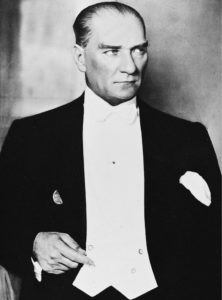
World War I brought defeat to the Ottoman Empire, and the victorious allies planned to divide its territory into various ethnic enclaves. This provoked the War for Turkish Independence, out of which emerged the modern nation of Turkey in 1923. The leader of the new nation was Mustafa Kemal, who served as President until his death in 1938. Mustafa Kemal, or Atatürk, “Father of the Turks,” rejected the imperial and pan-Islamic claims of the Ottoman Empire and built a republic on Turkish nationalism, secularist principles, Westernized institutions, and modern scientific understanding. The Turkish past (and present) was emphasized over the Ottoman or (pan-)Muslim. The offices of sultan and caliph were abolished, and Istanbul became the official name for the former imperial capital after he shifted the national capital to Ankara in Asia. Hagia Sophia was transformed to reflect a new ideological message, beginning its phase as a museum for the purpose of historical study and preservation, rather than religious worship. Moreover, public prayer was forbidden by law. This policy thwarted Muslim claims on the building, as well as Western voices calling for its restoration as a church. Over the following decades, the Byzantine mosaics, including those identified by the Fossati brothers, were uncovered and the removal of the prayer carpets revealed the marble floors discussed above. By the later twentieth century, UNESCO recognized Hagia Sophia as a World Heritage Site.
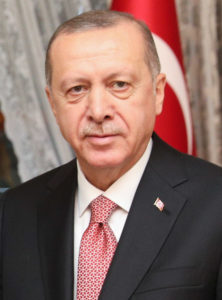
This brings us back to the present, when the secular foundation left by Mustafa Kemal has been sidelined by Recep Tayyip Erdoğan, formerly the Mayor of Istanbul, then Prime Minister and now President, and his Adalet ve Kalkınma Partisi, or AKP (Justice and Development Party), which has dominated the century’s opening decades. The AKP has undermined the legacy of Mustafa Kemal, promoted Ottoman and Muslim elements of the Turkish past (such as the Sultan Selim Bridge), and suppressed opposition. An extreme manifestation of opposition occurred on July 15, 2015, when a coup began against the government. Resistance began with the blocking of Istanbul’s bridges but collapsed within days. Those who died on behalf of the state the AKP hailed as martyrs, renaming the Bosphorus Bridge as the July 15 Martyrs Bridge. As expected, Hagia Sophia has a central role in this unfolding story. In 2020, Ayasofya Müzesi (“museum”) became Ayasofya Camii (“mosque”). The mosaics are again covered, not by plaster but by curtains, at least while an imam leads prayer. For visitors, there is no longer a fee to enter, as is true of every other mosque in the city, but all must now remove their shoes and women must wear head coverings.
That this should be the current use of Hagia Sophia reflects the norm established by rulers from the fourth century to the present and reveals the fundamental importance of this monumental bridge across time.
- Among the many studies on Hagia Sophia, here are some excellent places to begin: Robert Mark and Ahmet Çakmak, eds., Hagia Sophia from the Age of Justinian to the Present (Cambridge: Cambridge University Press, 1992); Ken Dark and Jan Kostenec, Hagia Sophia in Context: An Archaeological Re-Examination of the Cathedral of Byzantine Constantinople (Oxford: Oxbow Books, 2019); Robert S. Nelson, Hagia Sophia, 1850–1950. Holy Wisdom Modern Monument (Chicago: University of Chicago Press, 2004); a concise introduction is found in Judith Herrin, Byzantium: The Surprising Life of a Medieval Empire (Princeton: Princeton University Press, 2009), 50–60. For a contemporary reflection, see Anna Bigelow, “Hagia Sophia’s Tears and Smiles: The Ambivalent Life of a Global Monument,” in Istanbul: Living with Difference in a Global City, eds. Nora Fisher-Onar, Susan Pearce, and Fuat Keyman (Rutgers: Rutgers University Press, 2018), 112–127.
- For a historical overview of the Byzantine Empire, see Warren Treadgold, A History of the Byzantine State and Society (Stanford: Stanford University Press, 1997).
- On the reign of Justinian: J. A. S. Evans, The Age of Justinian: The Circumstances of Imperial Power (New York: Routledge, 1996); Michael Maas, ed., The Cambridge Companion to the Age of Justinian (New York: Cambridge University Press, 2005); and John Moorhead, Justinian (New York: Longman, 1994).
- Prokopios, On Buildings, trans. H. B. Dewing and Glanville Downey, Loeb Classical Library, book 1, no. 343 (Cambridge: Harvard University Press, 1940), 11, 21–23, 27.
- Paul the Silentiary, Description of Sancta Sophia, excerpt from Medieval Sourcebook, accessed August 13, 2021, https://sourcebooks.fordham.edu/source/paulsilent-hagsoph1.asp.
- Thomas Riha, ed., Readings in Russian History, vol. 1 (Chicago: Chicago University Press, 1969), 9.
- See Donald Queller and Thomas Madden, The Fourth Crusade: The Conquest of Constantinople (Philadelphia: University of Pennsylvania Press, 1997); and Jonathan Phillips, The Fourth Crusade and the Sack of Constantinople (New York: Penguin, 2004).
- On the reign of Sultan Mehmed II, see Franz Babinger, Mehmed the Conqueror and His Time, trans. Ralph Manheim (Princeton: Princeton University Press, 1978). For Istanbul in particular, see Halil Inalcik, “Istanbul: An Islamic City,” Journal of Islamic Studies 1, no. 1 (1990): 1–23. On the Ottoman Empire, see Caroline Finkel, Osman’s Dream: The History of the Ottoman Empire (New York: Basic Books, 2005).
- For a broader history of the Ottoman capital, see Philip Mansel, Constantinople. City of the World’s Desire, 1453–1924 (London: John Murray, 1995).

